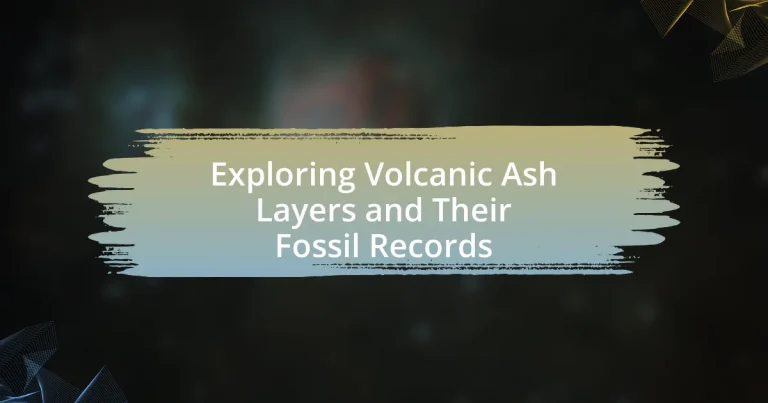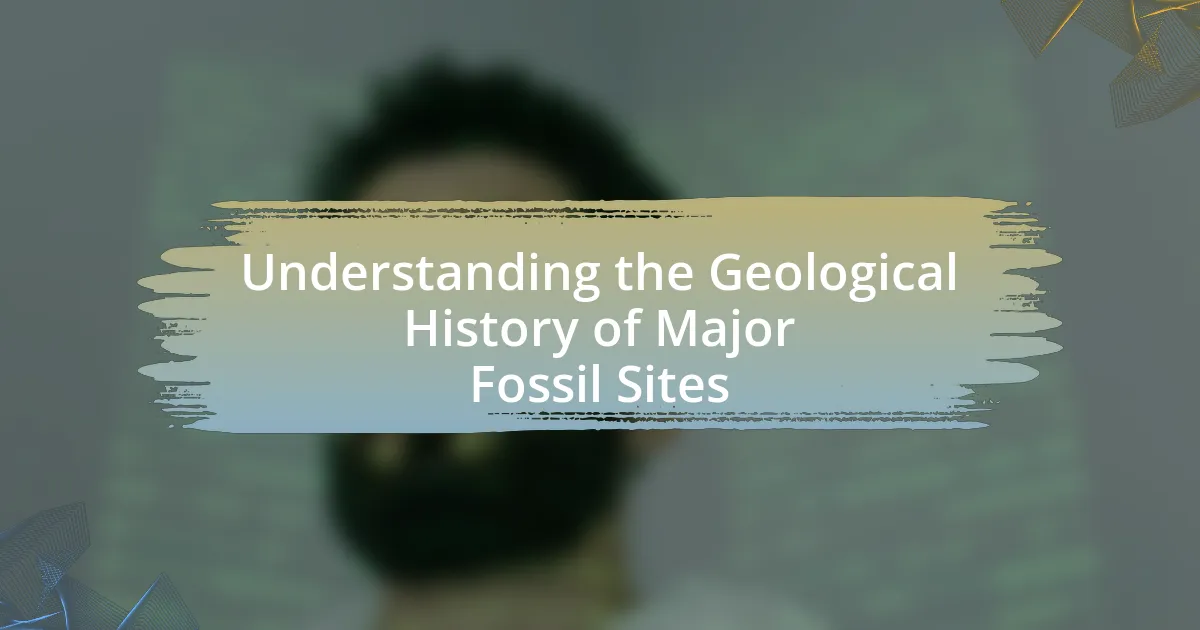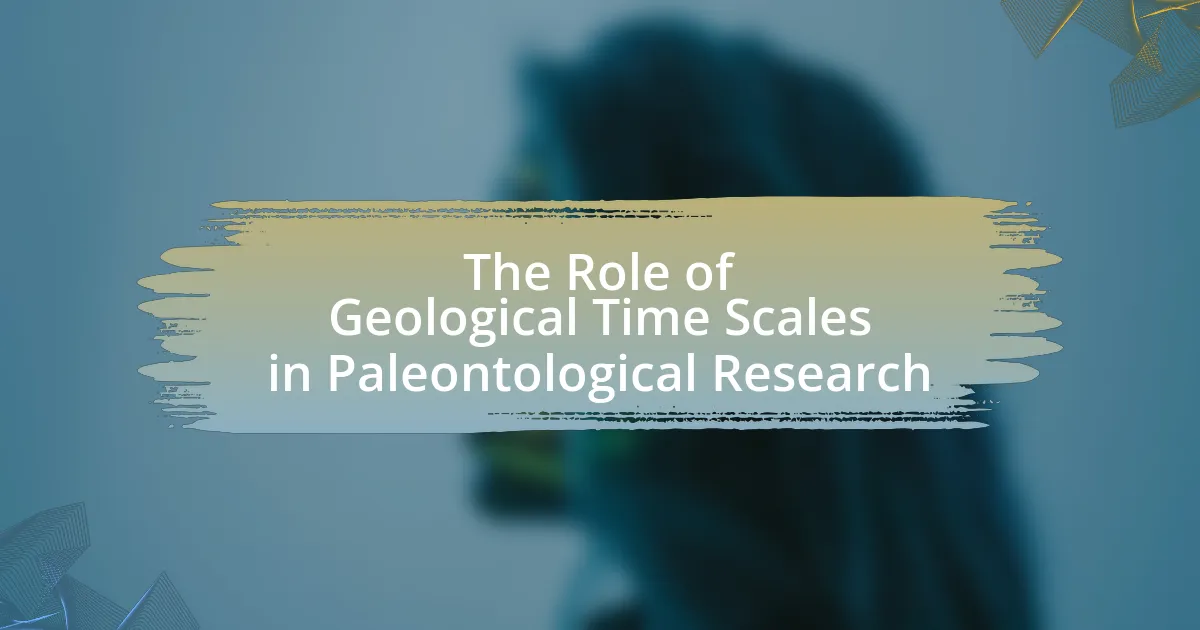Volcanic ash layers are geological deposits formed from fine particles ejected during explosive volcanic eruptions, providing critical insights into past volcanic activity, environmental changes, and fossil dating. These layers serve as chronological markers in sedimentary records, allowing researchers to analyze eruption frequency, magnitude, and the composition of erupted materials. The article explores the formation of volcanic ash layers, their role in the geological record, and the significance of fossil records found within these layers, highlighting techniques used for analysis and the implications for understanding historical biodiversity and climate changes. Additionally, it discusses best practices for researchers studying these phenomena, emphasizing the importance of systematic sampling and interdisciplinary collaboration.

What are Volcanic Ash Layers and Their Importance?
Volcanic ash layers are deposits of fine particles ejected during volcanic eruptions, which settle over time and form distinct geological layers. These layers are important because they provide valuable information about past volcanic activity, including eruption frequency, magnitude, and the composition of the erupted materials. Additionally, volcanic ash layers can serve as chronological markers in sedimentary records, aiding in the dating of fossils and understanding environmental changes over geological time. For instance, studies have shown that ash layers can be correlated with specific fossil assemblages, allowing researchers to reconstruct ancient ecosystems and climate conditions.
How are Volcanic Ash Layers Formed?
Volcanic ash layers are formed during explosive volcanic eruptions when magma is fragmented into fine particles and ejected into the atmosphere. The rapid expansion of gases within the magma causes it to shatter, resulting in the creation of ash that can be carried by wind over long distances. As these particles settle, they accumulate in layers on the Earth’s surface, often interspersed with other geological materials. Historical eruptions, such as the 1980 eruption of Mount St. Helens, have demonstrated this process, where significant ash deposits were formed and can be traced in the geological record.
What geological processes contribute to the formation of volcanic ash layers?
Volcanic ash layers form primarily through explosive volcanic eruptions that fragment magma and rock. During these eruptions, gases rapidly expand, causing the magma to shatter into fine particles that are ejected into the atmosphere. These particles, composed of volcanic glass, minerals, and rock fragments, settle back to the ground, creating ash layers. The 1980 eruption of Mount St. Helens serves as a concrete example, where the explosive activity produced significant ash deposits that spread over large areas, illustrating the direct relationship between explosive eruptions and ash layer formation.
How do different types of eruptions affect ash layer characteristics?
Different types of eruptions significantly influence the characteristics of ash layers. For instance, explosive eruptions typically produce finer ash particles that are dispersed over larger areas due to the high-velocity ejection of material, resulting in thicker and more widespread ash deposits. In contrast, effusive eruptions generate coarser ash with larger particles, leading to localized deposits that are often thinner. Studies, such as those by S. J. Self et al. in “Volcanic Ash: A Global Perspective,” demonstrate that the eruption style directly correlates with particle size distribution and layering, affecting the physical and chemical properties of the ash.
What Role Do Volcanic Ash Layers Play in the Geological Record?
Volcanic ash layers serve as important chronological markers in the geological record. These layers provide a means to date sedimentary sequences through radiometric dating techniques, such as argon-argon dating, which can determine the age of the ash itself. Additionally, volcanic ash layers can correlate geological events across vast distances, allowing scientists to establish a timeline of volcanic activity and its impact on the environment. For instance, the presence of a specific ash layer can indicate a significant eruption event, which can be linked to climate changes or mass extinction events, such as the Cretaceous-Paleogene boundary associated with the extinction of the dinosaurs.
How do volcanic ash layers assist in dating geological events?
Volcanic ash layers assist in dating geological events by providing distinct time markers in sedimentary sequences. These layers, formed during explosive volcanic eruptions, can be precisely dated using radiometric techniques such as potassium-argon dating, which measures the decay of radioactive isotopes. For example, the eruption of Mount St. Helens in 1980 produced ash layers that have been used to date subsequent geological formations accurately. This ability to correlate ash layers across different locations allows geologists to establish a timeline of events and understand the chronological sequence of geological processes.
What information can be gleaned from the composition of volcanic ash layers?
The composition of volcanic ash layers provides critical information about the eruption history, magma chemistry, and environmental conditions at the time of eruption. Analyzing the mineral content and chemical composition of ash can reveal the type of volcanic activity, such as explosive or effusive eruptions, and the source volcano’s characteristics. For instance, variations in ash composition can indicate different magma sources or changes in volcanic processes over time, as seen in studies of the 1980 Mount St. Helens eruption, which showed distinct ash layers correlating with specific eruptive phases. Additionally, the presence of certain elements, such as sulfur or chlorine, can inform researchers about past atmospheric conditions and potential climate impacts associated with volcanic events.
Why are Fossil Records Found in Volcanic Ash Layers Significant?
Fossil records found in volcanic ash layers are significant because they provide precise chronological context for the fossils, allowing scientists to date the organisms accurately. Volcanic ash layers act as time markers due to their rapid deposition during eruptions, which can be correlated with specific geological timeframes. For instance, the ash from the Toba supereruption approximately 74,000 years ago has been used to date fossils found in associated layers, establishing a timeline for the species that existed during that period. This correlation enhances our understanding of evolutionary processes and environmental changes, making volcanic ash layers crucial for paleontological studies.
What types of fossils are commonly found in volcanic ash layers?
Common types of fossils found in volcanic ash layers include plant remains, insect fossils, and small vertebrates. These fossils are preserved due to the rapid burial and low oxygen conditions created by the ash, which inhibits decay. For instance, the fossilized remains of ferns and other vegetation have been discovered in ash deposits from eruptions, providing insights into ancient ecosystems. Additionally, insect fossils, such as those of beetles and ants, have been identified, showcasing the biodiversity present at the time of the eruption. Small vertebrates, including fish and amphibians, are also commonly found, as they were often caught in the ashfall during volcanic events.
How do volcanic ash layers preserve fossils differently than other sedimentary layers?
Volcanic ash layers preserve fossils differently than other sedimentary layers primarily due to their rapid deposition and fine particle size. The quick accumulation of volcanic ash can encapsulate organisms almost instantaneously, reducing decay and scavenging, which often occurs in slower-depositing sedimentary environments. This rapid burial creates an anoxic environment that inhibits decomposition, allowing for exceptional fossil preservation. For instance, the fossilized remains found in the La Brea Tar Pits, which include volcanic ash deposits, demonstrate how such conditions can lead to well-preserved specimens, including soft tissues, that are rarely found in other sedimentary contexts.
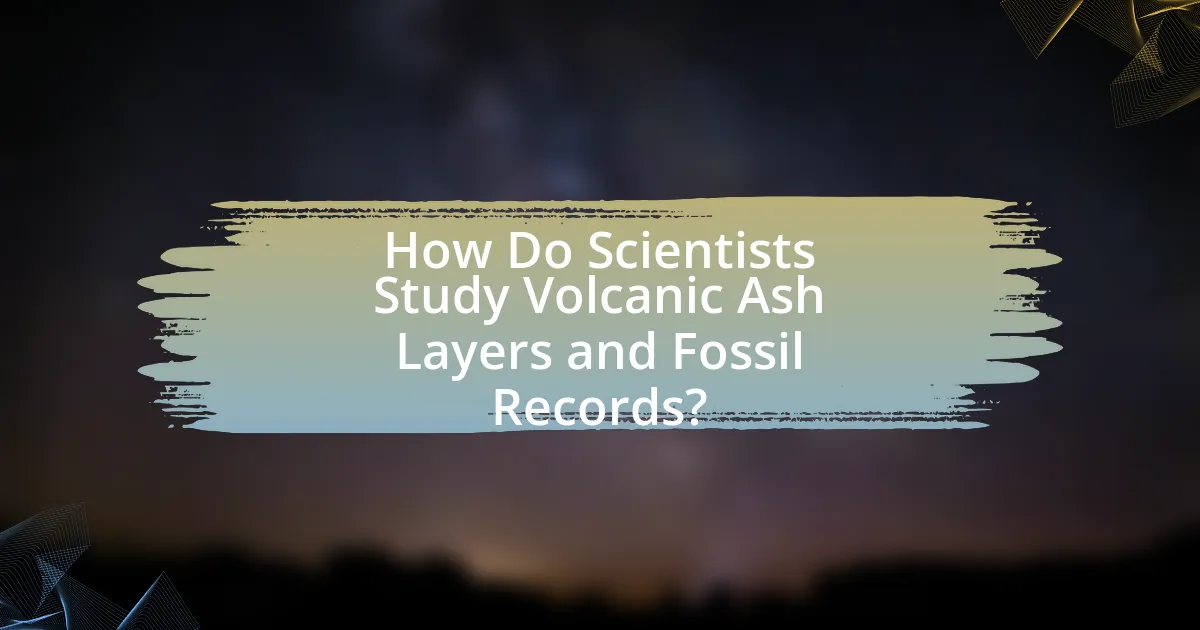
How Do Scientists Study Volcanic Ash Layers and Fossil Records?
Scientists study volcanic ash layers and fossil records primarily through stratigraphy, which involves analyzing the layers of sediment and rock to understand the chronological sequence of events. By examining the physical and chemical properties of volcanic ash, such as its mineral composition and grain size, researchers can correlate ash deposits with specific volcanic eruptions. This correlation allows scientists to date the layers accurately and understand the environmental conditions at the time of deposition. Additionally, fossil records found within these layers provide insights into past ecosystems and biodiversity, as the presence of certain fossils can indicate specific time periods and environmental conditions. For instance, the presence of a particular species of plant or animal can help date the layer and provide context for the climate during that time.
What Techniques are Used to Analyze Volcanic Ash Layers?
Techniques used to analyze volcanic ash layers include stratigraphy, geochemical analysis, and microscopy. Stratigraphy involves examining the layering of ash deposits to understand their chronological sequence and distribution. Geochemical analysis, such as X-ray fluorescence (XRF) and inductively coupled plasma mass spectrometry (ICP-MS), quantifies the elemental composition of ash, providing insights into the eruption’s source and intensity. Microscopy techniques, including scanning electron microscopy (SEM), allow for detailed examination of ash particle morphology and mineralogy, which can reveal information about the eruption’s conditions and the environment at the time of deposition. These methods collectively enhance the understanding of volcanic activity and its impact on the geological record.
How do geochemical analyses contribute to understanding ash layers?
Geochemical analyses significantly enhance the understanding of ash layers by providing detailed information about their chemical composition and origin. These analyses allow scientists to identify the elemental and isotopic signatures of ash, which can be linked to specific volcanic events or sources. For instance, studies have shown that variations in trace elements and isotopes, such as strontium and lead, can distinguish between different volcanic eruptions, thereby enabling researchers to reconstruct the history of volcanic activity in a region. This method has been validated in various studies, including the work by Houghton et al. (2015) in “Volcanic Ash: A Global Perspective,” which demonstrates how geochemical data can correlate ash layers with specific eruptions, enhancing the understanding of both the volcanic processes and the environmental impacts of these events.
What role does stratigraphy play in studying volcanic ash layers?
Stratigraphy plays a crucial role in studying volcanic ash layers by providing a framework for understanding the chronological sequence and distribution of these deposits. This discipline allows researchers to analyze the vertical and lateral variations in ash layers, which can reveal information about the frequency, intensity, and duration of volcanic eruptions. For instance, the identification of distinct stratigraphic units can help correlate ash deposits across different geographic locations, enabling scientists to reconstruct past volcanic activity and its impact on the environment. Additionally, stratigraphic analysis can assist in dating ash layers through radiometric techniques, further enhancing the understanding of the temporal aspects of volcanic events.
How are Fossil Records Extracted from Volcanic Ash Layers?
Fossil records are extracted from volcanic ash layers through a process that involves careful excavation and analysis of the ash deposits. Researchers identify layers of volcanic ash that have preserved organic materials, such as plant and animal remains, by examining the stratigraphy and dating the layers using radiometric techniques. The ash layers often encapsulate fossils, protecting them from decay and allowing for their preservation over geological time. This method has been validated by studies showing that volcanic ash can create an anoxic environment, which is conducive to fossil preservation, as seen in the fossil-rich deposits of the La Brea Tar Pits in California.
What methods are employed to recover fossils from ash deposits?
Fossils from ash deposits are primarily recovered using excavation, stratigraphic analysis, and sediment sampling methods. Excavation involves carefully removing layers of ash to expose fossilized remains, while stratigraphic analysis helps researchers understand the geological context and age of the deposits, which is crucial for locating fossils. Sediment sampling allows for the collection of smaller fossil fragments that may not be visible during excavation. These methods are validated by numerous paleontological studies that demonstrate their effectiveness in uncovering fossils preserved in volcanic ash, such as the findings from the La Brea Tar Pits, where stratigraphic techniques have been essential in fossil recovery.
How do researchers ensure the preservation of fossils during extraction?
Researchers ensure the preservation of fossils during extraction by employing careful excavation techniques and protective measures. They often use tools like brushes and small picks to gently remove surrounding material, minimizing damage to the fossil itself. Additionally, researchers may apply consolidants, which are chemical agents that stabilize the fossil and prevent deterioration during the extraction process. For instance, the use of polyvinyl acetate (PVA) is common in paleontology to reinforce fragile specimens. These methods are critical in maintaining the integrity of fossils, as improper handling can lead to irreversible damage.
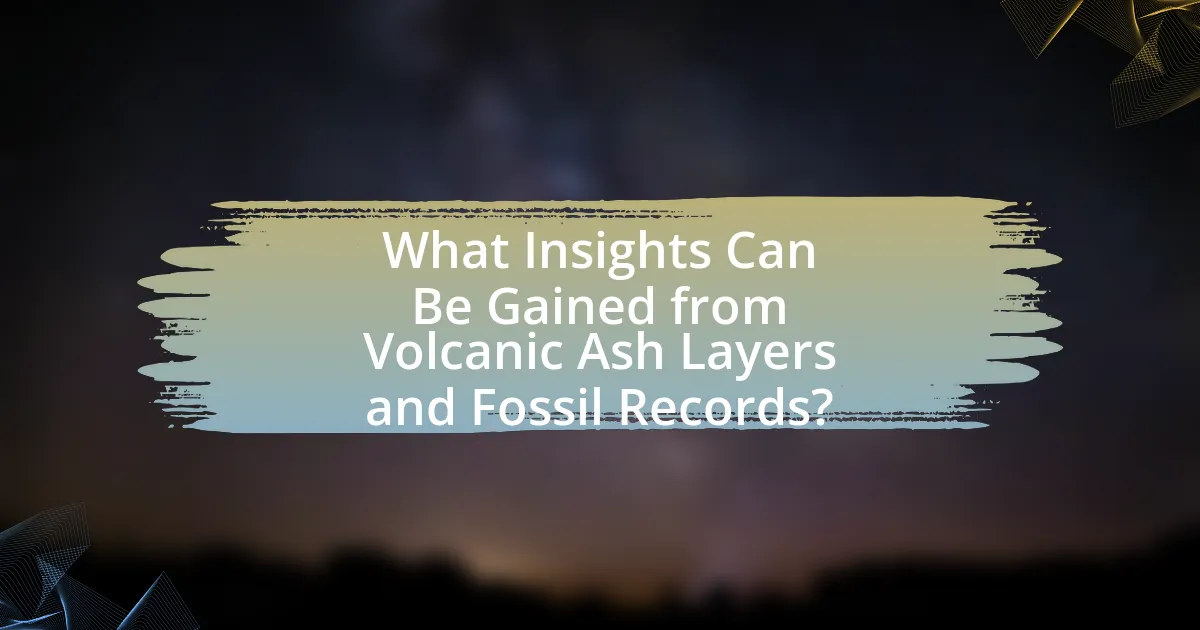
What Insights Can Be Gained from Volcanic Ash Layers and Fossil Records?
Volcanic ash layers and fossil records provide critical insights into past environmental conditions and biological evolution. The ash layers serve as chronological markers, allowing scientists to date geological events and correlate them with fossilized organisms found in the same strata. For instance, the presence of specific ash layers can indicate periods of volcanic activity, which may have influenced climate and habitat changes, thereby affecting the evolution and extinction of species. Studies, such as those conducted by the Geological Society of America, demonstrate that analyzing these layers can reveal patterns of biodiversity and extinction events linked to volcanic eruptions, providing a clearer understanding of Earth’s historical climate and ecological shifts.
How Do Volcanic Ash Layers Inform Us About Past Environments?
Volcanic ash layers inform us about past environments by providing chronological markers that indicate volcanic activity and its impact on the surrounding ecosystem. These layers can reveal information about the climate, vegetation, and geological events at the time of deposition. For instance, the presence of specific minerals and chemical compositions in the ash can indicate the type of volcanic eruption and the environmental conditions that prevailed during that period. Studies, such as those conducted by the United States Geological Survey, demonstrate that analyzing ash layers can help reconstruct past climates and ecological changes, offering insights into how ecosystems responded to volcanic events over time.
What can the presence of certain fossils indicate about historical climates?
The presence of certain fossils can indicate historical climates by revealing the environmental conditions in which the organisms lived. For example, fossils of marine organisms, such as coral and foraminifera, suggest warm, shallow seas, while the presence of plant fossils like ferns indicates a humid, tropical climate. Additionally, the discovery of glacial deposits and associated fossils, such as those of cold-adapted species, points to periods of significant cooling. These fossil records provide critical evidence for reconstructing past climates, as they reflect the specific ecological niches and climatic conditions that existed at the time of their deposition.
How do volcanic ash layers contribute to our understanding of biodiversity changes?
Volcanic ash layers contribute to our understanding of biodiversity changes by providing chronological markers that correlate with fossil records, allowing scientists to track shifts in species composition over time. These layers often preserve plant and animal remains, enabling researchers to analyze the ecological impact of volcanic events on local and regional biodiversity. For instance, studies have shown that the ash from the Toba supereruption around 74,000 years ago coincided with significant changes in species diversity in Southeast Asia, illustrating how volcanic activity can influence evolutionary trajectories and extinction events.
What Are the Implications of Studying Volcanic Ash Layers for Modern Science?
Studying volcanic ash layers has significant implications for modern science, particularly in understanding Earth’s geological history and climate change. These layers serve as chronological markers that help scientists reconstruct past volcanic activity, which is crucial for assessing the frequency and impact of eruptions on ecosystems and human societies. For instance, the analysis of ash layers can reveal information about the composition of the atmosphere during different geological periods, aiding in climate modeling. Additionally, volcanic ash can preserve fossil records, providing insights into past biodiversity and evolutionary processes. Research has shown that ash layers can be correlated with specific climatic events, such as the Younger Dryas, enhancing our understanding of the interactions between volcanic activity and climate shifts.
How can insights from volcanic ash layers aid in predicting future volcanic activity?
Insights from volcanic ash layers can significantly aid in predicting future volcanic activity by providing historical data on eruption patterns and the chemical composition of past eruptions. Analyzing the stratigraphy of ash deposits allows scientists to identify the frequency, magnitude, and style of previous eruptions, which can be correlated with current volcanic behavior. For instance, studies have shown that specific ash layers correspond to particular volcanic events, enabling researchers to establish a timeline of activity. This historical context is crucial for assessing the likelihood of future eruptions, as seen in regions like Mount St. Helens, where ash layer analysis has informed eruption forecasts.
What relevance do these studies have for understanding current ecological changes?
Studies on volcanic ash layers and their fossil records are crucial for understanding current ecological changes as they provide insights into past environmental conditions and biological responses to climatic shifts. By analyzing the composition and distribution of ash layers, researchers can reconstruct historical ecosystems and identify patterns of biodiversity and extinction events linked to volcanic activity. For instance, the study “Volcanic Ash and Its Impact on Ecosystems” published in the journal Ecological Applications demonstrates how ash deposition influenced soil fertility and plant succession, thereby affecting animal populations. This historical context allows scientists to draw parallels with contemporary ecological changes, such as habitat loss and species adaptation, thereby enhancing our understanding of how current ecosystems might respond to ongoing environmental stressors.
What Best Practices Should Researchers Follow When Studying Volcanic Ash Layers and Fossil Records?
Researchers studying volcanic ash layers and fossil records should prioritize systematic sampling and stratigraphic analysis. Systematic sampling ensures that data is collected uniformly across different layers, allowing for accurate comparisons and interpretations. Stratigraphic analysis helps in understanding the chronological sequence of events, which is crucial for correlating ash layers with specific fossil records.
Additionally, researchers should utilize geochemical analysis to characterize the composition of volcanic ash, as this can provide insights into the eruption history and environmental conditions at the time of deposition. For instance, studies have shown that the geochemical fingerprint of ash can be linked to specific volcanic events, aiding in the dating of fossil layers.
Collaboration with geologists and paleontologists is also essential, as interdisciplinary approaches enhance the understanding of the relationship between volcanic activity and biological responses. This collaboration can lead to more comprehensive models of past ecosystems affected by volcanic eruptions.
Finally, maintaining meticulous records of field observations and sample locations is critical for reproducibility and validation of findings, as emphasized in various geological studies.
